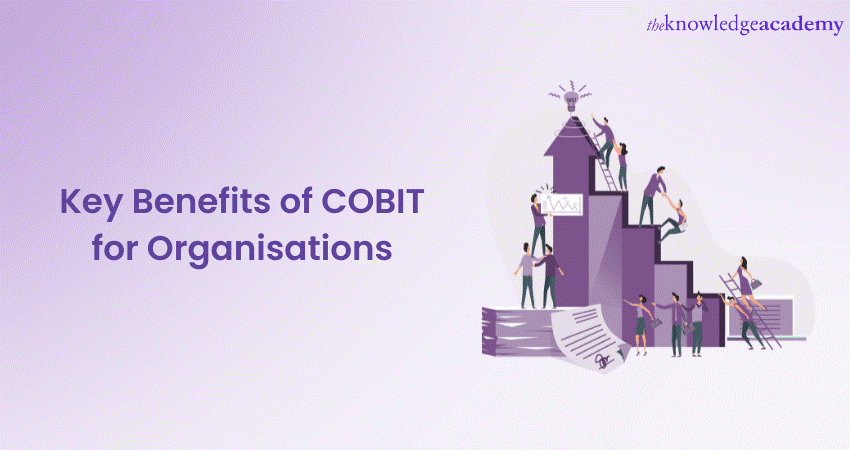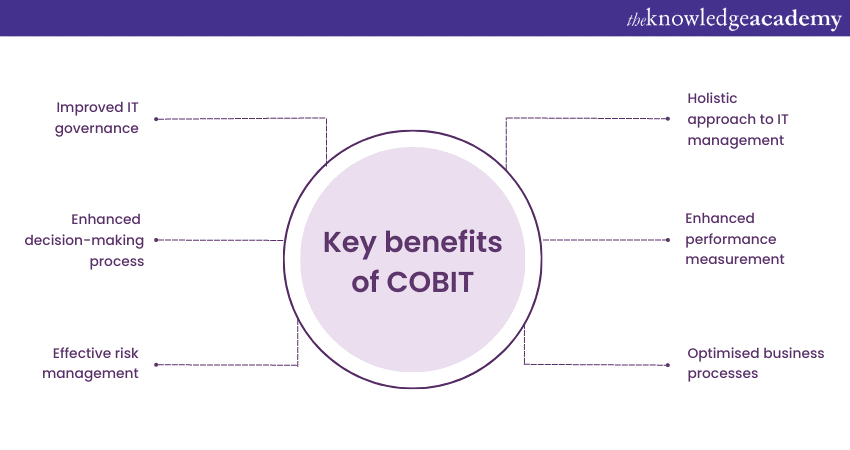We may not have the course you’re looking for. If you enquire or give us a call on +0800 780004 and speak to our training experts, we may still be able to help with your training requirements.
We ensure quality, budget-alignment, and timely delivery by our expert instructors.

Technology is transforming the world of business at a rapid pace, creating new opportunities and challenges for organisations of all sizes and sectors. To survive in this dynamic environment, organisations need to ensure that their information and technology are aligned with their strategic objectives, while also managing the risks and complexities that come with them. This is where the organisations can leverage various Benefits of COBIT.
By adopting COBIT, organisations get guidance and best practices for effective Governance and Management of Information Technology (IT). So, to build robust IT infrastructure in your organisation, explore the Benefits of COBIT,and efficiently govern and manage IT operations of your organisation. Read ahead to learn more!
Table of Contents
1) What is COBIT?
2) Key Benefits of COBIT for organisations?
a) Improved IT Governance
b) Enhanced decision-making process
c) Effective risk management
d) Optimised business processes
e) Enhanced performance measurement
f) Holistic approach to IT Management
3) Real-world examples
4) Conclusion
What is COBIT?
The Information Systems Audit and Control Association (ISACA) developed the Control Objectives for Information and Related Technology (COBIT) framework to provide organisations with a structured approach to govern and manage the IT infrastructure. This framework helps align with business objectives and technology, minimise risks, and effectively control IT-related activities.
COBIT was initially introduced to address the challenges organisations face in effectively managing and utilising technology. As technology became increasingly integral to business operations, the need for a comprehensive framework to guide IT Governance, risk management, and compliance became evident.

Key Benefits of COBIT for organisations?
COBIT is helpful for organisations seeking to enhance IT Governance, manage risks, and align technology initiatives with business objectives. Let's explore the key Benefits of COBIT:

Improved IT Governance
COBIT establishes a clear framework for defining roles, responsibilities, and decision-making processes within an organisation's IT environment, helping clarify the difference between IT Governance and IT Management, where governance focuses on strategic alignment and control, while management focuses on the day-to-day operations. This clarity ensures that individuals and teams understand their roles in the governance structure, reducing ambiguity and the potential for miscommunication. Thus, with well-defined accountability, organisations can make informed decisions more efficiently.
Enhanced decision-making process
COBIT enables organisations to make well-informed decisions about technology investments, projects, and initiatives by providing a structured approach to IT Governance. The framework emphasises aligning IT decisions with overall business goals, As a results, it ensures that IT investments contribute directly to value creation. This alignment leads to more strategic decision-making that positively impacts the organisation's bottom line.
Effective risk management
COBIT assists organisations in identifying and managing IT-related risks that could impact business operations and objectives. It provides a systematic method for assessing IT processes, applications, and infrastructure risks. By addressing potential vulnerabilities and threats, organisations can implement controls and measures to mitigate risks before they escalate into significant issues.
Optimised business processes
COBIT bridges the gap between IT and business by aligning IT activities and goals with the broader organisational strategy. This alignment ensures that technology initiatives are driven by business needs and objectives, helping effectively use resources and improve the chances of achieving success.
COBIT helps organizations streamline their IT operations by emphasizing process efficiency and resource optimization. With the growing demand for COBIT jobs, professionals skilled in this framework play a crucial role in helping organizations allocate resources more effectively and reduce operational costs by identifying redundant or inefficient processes. This optimization enhances overall organizational efficiency and responsiveness.
Enhanced performance measurement
COBIT provides a set of predefined Key Performance Indicators (KPIs) that help organisations measure the effectiveness of their IT processes. These KPIs offer quantifiable metrics for assessing the performance of various IT activities. With accurate measurement, organisations can track progress, identify areas for improvement, and make data-driven decisions.
After measuring performance and analysing KPI data, organisations gain valuable insights into their IT operations. These insights enable informed decision-making and facilitate a culture of continuous improvement. Moreover, organisations can identify bottlenecks, inefficiencies, and opportunities for enhancement, driving a cycle of ongoing optimisation.
Holistic approach to IT Management
COBIT integrates seamlessly with other well-known frameworks and standards, like the Information Technology Infrastructure Library (ITIL) and ISO 27001 Information Security Management System. This integration enables organisations to adopt a cohesive approach to IT management, leveraging the strengths of multiple frameworks while avoiding duplication of efforts.
Want to align your IT resources effectively with your business goals? Learn now with our COBIT® Foundation Course.
Real world examples
The practical application of COBIT has demonstrated its value across various industries and organisational sizes. Let's explore two real-world examples of organizations that have leveraged the benefits of the COBIT Framework PDF:
Case Study 1: Enhancing security and compliance in the financial sector.
Organisation: A global financial institution with a vast network of branches and digital services.
Challenge: The financial institution faced difficulties in maintaining robust information security practices and complying with stringent regulatory requirements across its numerous operations. The dynamic nature of cyber threats and evolving regulations necessitated a proactive approach.
COBIT solution:
a) The organisation implemented COBIT's control objectives and guidelines to establish a comprehensive information security framework.
b) COBIT's mapping to relevant regulatory standards helped ensure alignment with financial industry regulations.
Boost your confidence – prepare with these key IT Governance Interview Questions!
Case Study 2: Driving IT innovation in a tech startup
Organisation: A technology startup focusing on developing cutting-edge software solutions.
Challenge: The startup aimed to rapidly develop and deploy innovative software products while maintaining effective governance and risk management practices. The challenge was to balance agility with control.
COBIT solution:
a) The startup adopted COBIT's framework to establish a structured Governance model for IT projects and operations.
b) COBIT's maturity models guided the organisation in assessing and improving its IT processes iteratively.
Gain confidence with our carefully curated Cobit Interview Questions and Answers. Begin your journey today!
Conclusion
We hope you enjoyed reading this blog and gained valuable insights into the Benefits of COBIT, a cornerstone of modern IT Governance and Management. Its benefits include improved decision-making, risk mitigation, compliance, process optimization, performance measurement, and a holistic approach to IT activities. As organizations navigate the complexities of technology integration, regulatory compliance, and strategic growth, embracing COBIT is a strategic choice that can guide them toward a future of efficiency, effectiveness, and success. For those exploring other frameworks like Coso vs Cobit, it’s important to understand how each contributes to the broader landscape of governance and risk management. By incorporating COBIT into their practices, organizations can position themselves to thrive in the digital era and turn technology into a driving force behind their achievements.
Boost your career with an edge in IT Governance - secure your spot in our next COBIT Training session today!
Frequently Asked Questions
What are the Benefits of COBIT?

COBIT offers numerous benefits for organisations. It enhances operational efficiency by aligning IT strategies with business objectives, ensuring a clear understanding of technology's contribution. The framework facilitates effective risk management and compliance, reducing the likelihood of regulatory issues. COBIT also promotes transparency, providing stakeholders with a comprehensive view of IT processes.
How long will it take to learn the COBIT 5 material?

The time required to learn COBIT 5 material varies based on individual factors such as prior experience and study habits. On average, dedicating 40-60 hours of focused study should provide a solid understanding. Beginners might need more time, while those with related knowledge may grasp concepts faster.
What are the other resources and offers provided by The Knowledge Academy?

The Knowledge Academy takes global learning to new heights, offering over 3,000 online courses across 490+ locations in 190+ countries. This expansive reach ensures accessibility and convenience for learners worldwide.
Alongside our diverse Online Course Catalogue, encompassing 19 major categories, we go the extra mile by providing a plethora of free educational Online Resources like News updates, Blogs, videos, webinars, and interview questions. Tailoring learning experiences further, professionals can maximise value with customisable Course Bundles of TKA.
What is Knowledge Pass, and how does it work?

The Knowledge Academy’s Knowledge Pass, a prepaid voucher, adds another layer of flexibility, allowing course bookings over a 12-month period. Join us on a journey where education knows no bounds.
What are related courses and blogs provided by The Knowledge Academy?

The Knowledge Academy offers various COBIT Training, including COBIT® Foundation. The course caters to different skill levels, providing comprehensive insights into What is COBIT?
Our IT Service Management blogs covers a range of topics related to COBIT, offering valuable resources, best practices, and industry insights. Whether you are a beginner or looking to advance your IT Service skills, The Knowledge Academy's diverse courses and informative blogs have you covered.
Upcoming IT Service Management Resources Batches & Dates
Date
 COBIT® Foundation
COBIT® Foundation
Thu 12th Jun 2025
Thu 4th Sep 2025
Thu 13th Nov 2025






 Top Rated Course
Top Rated Course


 If you wish to make any changes to your course, please
If you wish to make any changes to your course, please


